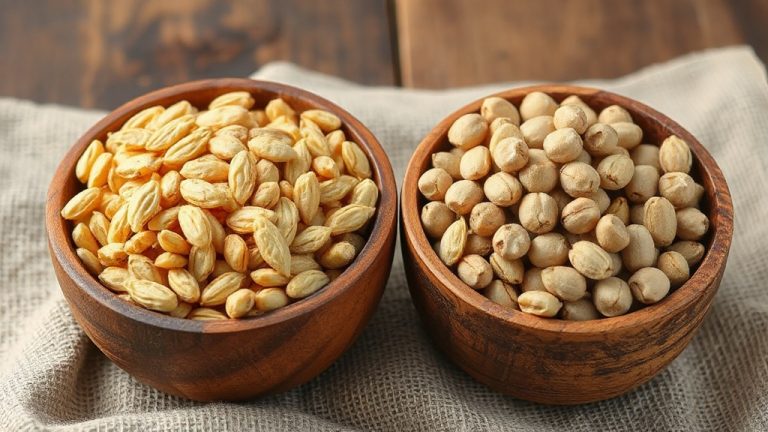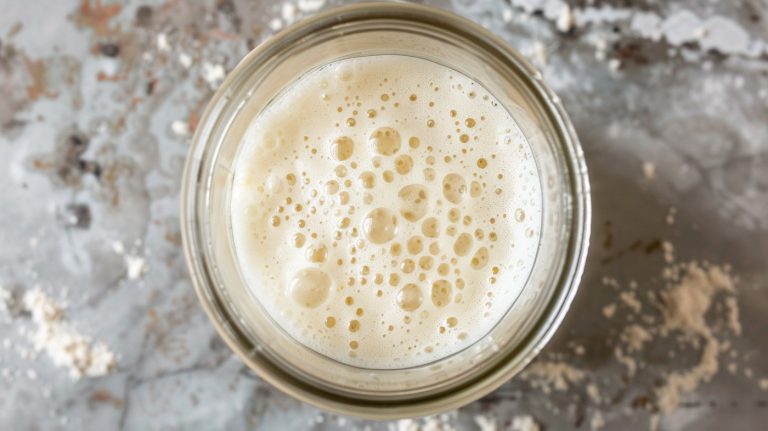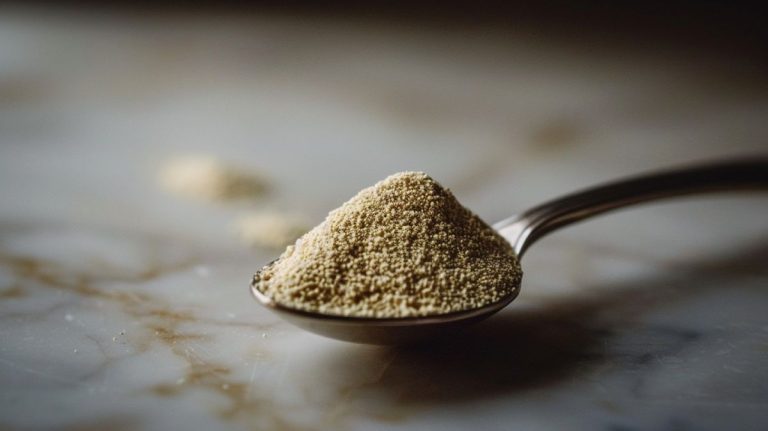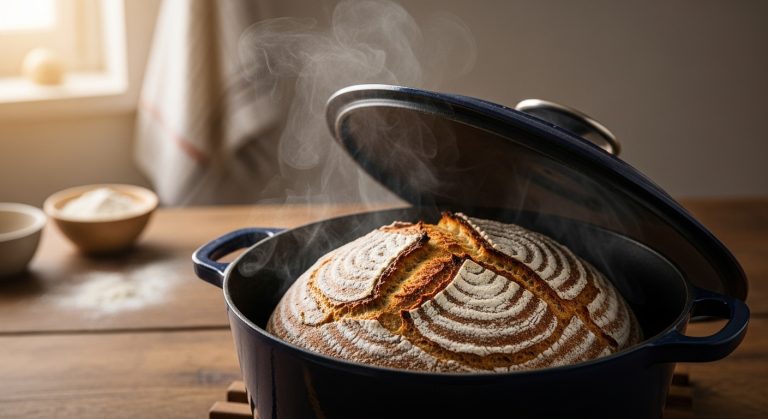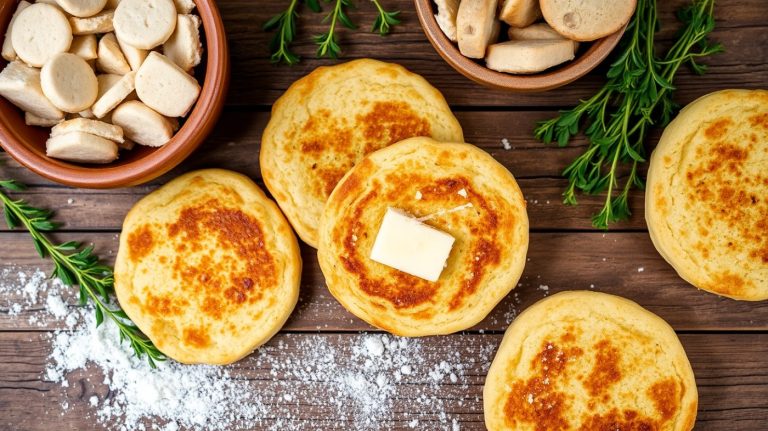High Protein Sourdough Discard Recipes: Healthy Breakfast Treats
You can easily transform your sourdough discard into tasty high-protein delights like waffles, muffins, and bagels by adding ingredients such as eggs, Greek yogurt, or protein powder.
This boosts nutrition and keeps baked goods moist and flavorful while reducing waste.
Combining discard with whole grains or seeds further enhances protein and texture for satisfying meals.
These recipes offer versatile, nutrient-rich options perfect for snacks or breakfast.
Keep exploring to discover how to perfect texture, flavor, and sustainable cooking with your discard.
Key Takeaways
- Boost protein in sourdough discard recipes by adding Greek yogurt, eggs, and high-quality protein powders like whey for enhanced nutrition and texture.
- Use sourdough discard to make protein-rich waffles, muffins, brownies, crepes, and Dutch baby pancakes with added protein boosters and whole grain flours.
- Incorporate seeds (hemp, flax, chia) or nut butters into discard recipes for plant-based protein, fiber, and improved flavor complexity.
- Combine sourdough discard with chickpea, quinoa, or whole wheat flour to increase protein and fiber in baked goods and snacks.
- Develop chewy, protein-packed bagels and pizza crusts using discard, bread flour, yeast, and proper fermentation for rich flavor and texture.
High Protein Sourdough Discard Recipe Collection
| Recipe Type | Protein Content | Prep Time | Key Protein Boosters | Best For |
|---|---|---|---|---|
| Protein Waffles | 16-22g per serving | 15 minutes | Greek yogurt, eggs, protein powder | Breakfast, meal prep |
| High-Protein Muffins | 8-10g per muffin | 25 minutes | Whey protein, Greek yogurt, eggs | Snacks, on-the-go |
| Sourdough Bagels | 11-13g per bagel | 45 minutes | Cottage cheese, bread flour | Breakfast, sandwiches |
| Protein Pancakes | 12-15g per serving | 10 minutes | Eggs, protein powder, milk | Quick breakfast |
| Savory Pizza Crust | 8-12g per slice | 30 minutes | Chickpea flour, eggs | Dinner, entertaining |
| Protein Brownies | 5-7g per serving | 35 minutes | Protein powder, nut butter | Desserts, treats |
Benefits of Using Sourdough Discard in Protein Recipes
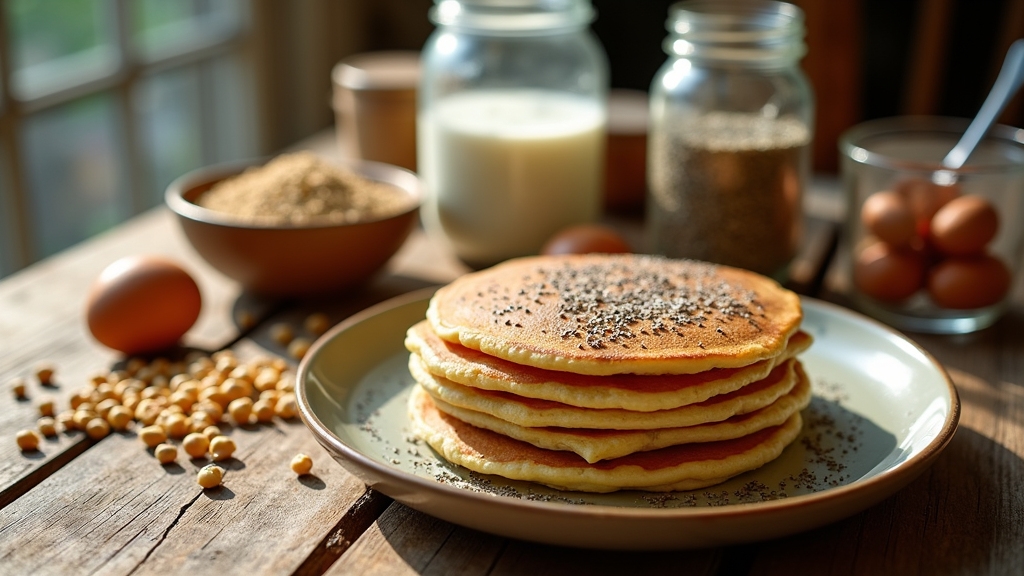
When you incorporate sourdough discard into your protein recipes, you not only boost their nutritional value but also enhance digestion and nutrient absorption.
A cup of sourdough discard offers 12.5 grams of protein, about 25% of your daily need, without adding much fat. For best results in sourdough recipes, using a mixer with at least 500W motor power can help achieve optimal dough consistency.
Its fermentation process improves protein quality, making amino acids easier for your body to use.
Plus, it provides essential minerals like iron, calcium, and potassium that support overall health.
The natural probiotics and dietary fiber in sourdough discard promote a healthy gut, aiding digestion and easing discomfort after meals. This contributes to a healthy gut microbiome that supports immune function and reduces inflammation.
Fermentation also reduces antinutrients, so your body absorbs more minerals and nutrients efficiently.
How to Boost Protein Content With Sourdough Discard?
Hey there! Did you know that you can easily boost the protein content in your sourdough discard recipes? It’s true! Just by adding a few ingredients like eggs, Greek yogurt, or even whey protein powder, you can amp up the nutrition.
And here’s something cool: sourdough’s natural fermentation process actually enhances protein digestibility. So, not only are you making your baked goods more nutritious, but they’re also easier on your stomach. Pretty neat, right? Using a digital baking scale can help you measure these ingredients precisely for optimal results.
Plus, incorporating sourdough discard into recipes can help reduce food waste by repurposing the discard creatively.
Let’s dive into how these protein boosters work together with sourdough’s benefits to create some delicious, high-protein treats!
Protein Enhancer Options
Although sourdough discard itself offers some protein, you can considerably boost the protein content in your recipes by incorporating various enhancers like protein powders, dairy products, seeds, nuts, and alternative flours.
Mix whey, pea, or collagen protein powders directly into your batter for a significant protein lift; flavors like vanilla or chocolate blend seamlessly without altering taste. Using a high-quality protein powder such as Just Ingredients can improve the texture and flavor of your baked goods, avoiding dryness or off tastes caused by inferior powders protein powder quality. Creative uses for discard can include pancakes, waffles, and muffins, which are perfect bases for protein enhancement.
Greek yogurt and eggs add moisture and structure while enriching protein content, perfect for waffles or bagels.
Sprinkle in hemp, flax, or chia seeds, or fold nut butters into your mix for plant-based protein and extra texture. These additions also complement the flavor enhancements often used in sourdough discard recipes.
Swap out all-purpose flour for chickpea, quinoa, or whole wheat flour to increase both protein and fiber.
These options help you tailor nutrient density and texture, making your sourdough discard recipes both delicious and protein-packed.
Sourdough Nutritional Benefits
How does sourdough discard contribute to your diet beyond just flavor? It’s a nutritional powerhouse that preserves fermentation benefits like improved protein digestibility and mineral bioavailability.
Different types of sourdough, such as whole-wheat and rye, can influence the nutritional profile and flavor complexity of your recipes, offering diverse health benefits and taste experiences.
Sourdough bread itself offers up to 12 grams of protein per 100 grams, and whole-grain varieties boost this further with added fiber. Thanks to fermentation, phytic acid levels drop, releasing minerals such as iron, calcium, and zinc for better absorption. This makes sourdough a superior choice compared to many store-bought breads in terms of protein content and nutrient availability.
When you incorporate sourdough discard into your recipes, you retain these enzymatic properties, helping your body access nutrients more efficiently. Pair discard with high-protein ingredients to naturally elevate your dish’s protein content without relying on artificial additives.
This way, you’ll enjoy a tasty, nutrient-rich boost that supports overall health and muscle maintenance. Moreover, the texture of sourdough can be adjusted through fermentation and hydration to suit different culinary preferences while maintaining its nutritional advantages.
Protein Waffles Made With Sourdough Discard
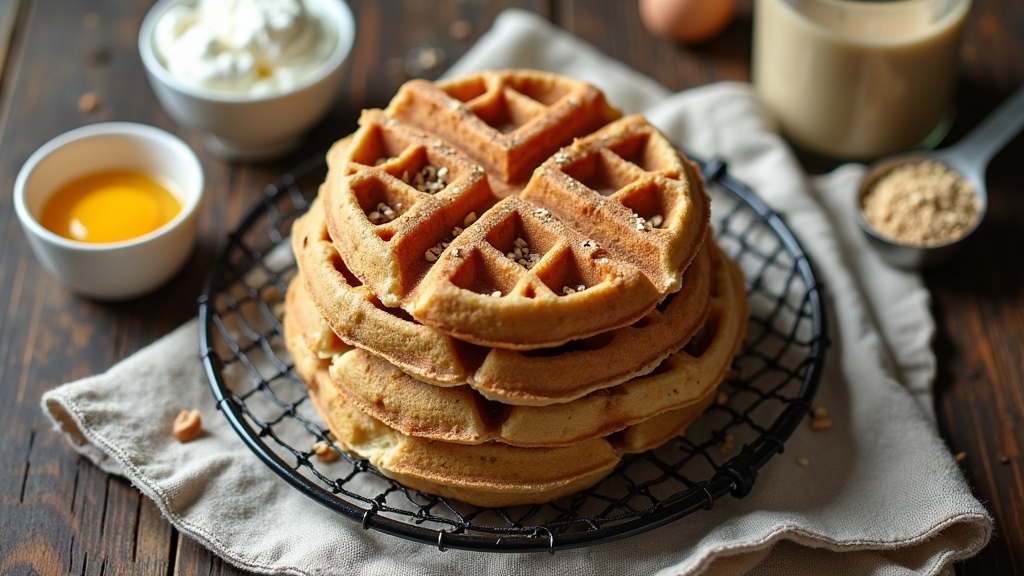
When crafting protein waffles with sourdough discard, combining equal parts of discard and Greek yogurt creates a moist, tangy base that balances richness and nutrition. This method also helps utilize sourdough discard, minimizing waste in your kitchen.
You’ll boost protein by adding 3 to 6 large eggs and 1-2 scoops of protein powder, pushing each serving to 16-22 grams of protein.
Including buttermilk or milk adds moisture and activates leavening agents like baking powder and baking soda, giving you light, fluffy waffles with a golden crust. The fermentation process in sourdough discard also enhances digestibility and flavor, contributing to a better-tasting waffle.
Mix wet ingredients first, then gently fold in dry to avoid toughness. Using melted butter or coconut oil adds richness and helps achieve a crisp texture on the outside.
Preheat your waffle iron and cook about 1/4 cup batter per waffle until golden brown.
The tangy sourdough flavor complements the richness of dairy and eggs, making these waffles ideal for high-protein meal plans and active lifestyles.
Creating Moist Protein Muffins Using Sourdough Discard
Since sourdough discard naturally adds moisture and a subtle tang, it’s an ideal ingredient for crafting protein-rich muffins that stay soft and flavorful. Using sourdough discard also helps reduce food waste by incorporating a byproduct into your baking.
You can boost protein by adding whey or flavored protein powders, while moisture comes from Greek yogurt, eggs, and mashed fruits. Combining these ingredients carefully can improve dough extensibility and tenderness, similar to how sourdough discard enhances pretzel dough.
Combine dry ingredients carefully, fold in wet ones gently, and avoid overmixing to keep muffins tender. Sourdough fermentation enhances nutrition by making the muffins easier to digest compared to traditional yeast bread.
Baking at a high initial temperature then lowering it preserves moisture and texture.
| Ingredient | Role | Benefit |
|---|---|---|
| Sourdough Discard | Moisture & flavor | Adds tang, keeps muffins soft |
| Protein Powder | Protein boost | Yields 8-10g protein/muffin |
| Greek Yogurt | Moisture & protein | Enhances tenderness and richness |
Follow these tips to create moist, protein-packed muffins your whole family will love.
Crafting Chewy Protein Bagels From Sourdough Discard
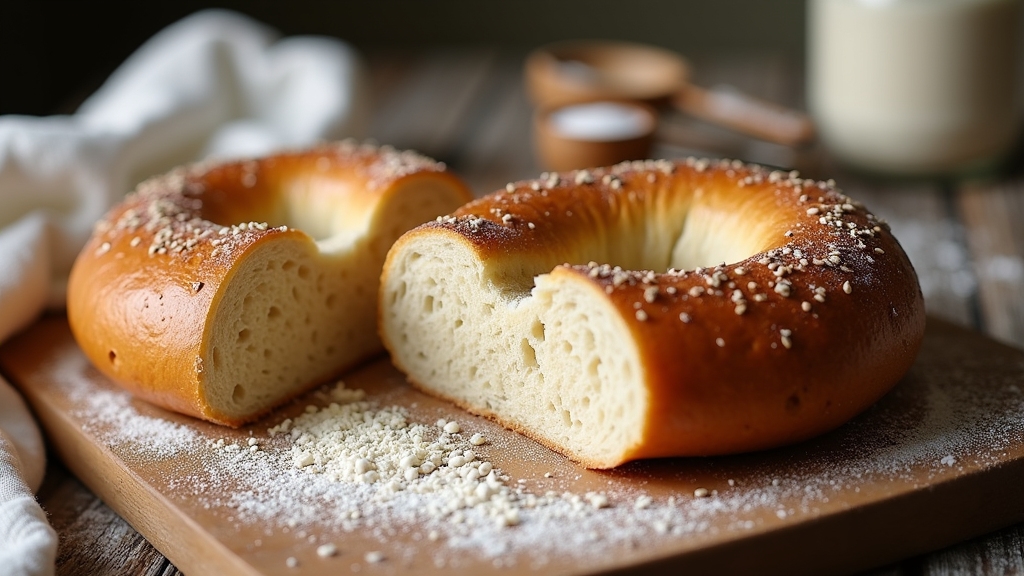
Combining sourdough discard with high-protein ingredients like Greek yogurt or cottage cheese transforms ordinary dough into a chewy, protein-packed bagel that’s both satisfying and flavorful.
You’ll mix the moist, shaggy dough with bread flour and a touch of yeast to boost rise and texture. Then let it proof twice for ideal chewiness. Using an oven with precise temperature controls can help achieve consistent results.
For a quicker option, you can skip the long fermentation and boiling steps and still enjoy a tangy sourdough flavor by using sourdough discard combined with Greek yogurt to make bagels ready in about 30 minutes with minimal effort quick preparation.
Before baking, boil your shaped bagels briefly in baking soda water to develop that classic crust. Baking at around 400°F for 25–30 minutes gives you a golden, crisp exterior.
Customize with toppings like sesame seeds or everything bagel seasoning, brushing on egg wash for shine and adhesion.
These bagels pack 11–13 grams of protein each, making them a nutritious, delicious way to use sourdough discard while enjoying artisan-quality bread at home. Using multi-function appliances with steam and air frying technology can enhance texture and reduce cooking time.
Choosing the Right Protein Enhancers for Sourdough Recipes
Although selecting protein enhancers for sourdough recipes might seem straightforward, choosing the right type requires understanding their distinct effects on dough behavior, flavor, and nutrition.
Whey protein concentrate is a great neutral option, promoting oven spring, an open crumb, and a crispy crust without altering flavor.
Casein powder absorbs more water, so you’ll need to adjust hydration to prevent dryness and achieve a finer crumb.
Plant-based proteins like pea or chickpea concentrates boost protein content while supporting gluten minimization, though they may affect dough moisture and structure.
Whey liquid can substitute water in your starter or dough, enhancing protein and nutrients but speeding fermentation.
Rye and whole grain flours indirectly increase protein by fostering beneficial bacteria, improving fermentation and texture without compromising sourdough’s character.
Choose enhancers based on your recipe goals and handling preferences.
It is also important to store ingredients properly, as moisture can promote mold growth even in sealed environments, which can affect dough quality.
Texture and Flavor Profiles in High-Protein Sourdough Dishes
When you work with high-protein sourdough flours, you’ll notice a distinct impact on both texture and flavor that sets these breads apart.
The strong gluten network creates elastic, resilient dough and an open crumb with large holes, hallmark traits of artisan sourdough. Proper bulk fermentation is essential to develop these characteristics fully.
However, too much protein can toughen the crumb and crust if hydration and fermentation aren’t carefully managed.
Flavor-wise, higher protein flours boost Maillard reactions, deepening crust color and adding rich, toasty notes.
The sourdough discard contributes a tangy acidity that enhances complexity but can overwhelm if overused. It typically consists of flour, water, and wild yeast and often has a tangy flavor profile due to fermentation.
Balancing discard moisture and acidity with protein content guarantees a tender crumb and nuanced sourness.
Mastering these elements lets you craft high-protein sourdough dishes with both bold texture and sophisticated flavor.
Sustainable Cooking: Reducing Waste With Sourdough Discard
If you want to embrace sustainable cooking, reducing sourdough discard waste is a smart place to start.
Instead of tossing this nutrient-rich byproduct, you can repurpose it in delicious recipes or compost it to enrich your garden soil. Managing your starter smartly also cuts down waste and resource use. Martha’s formula for a healthy starter involves discarding all but 1/4 cup (60g) starter once a day and feeding it with specific amounts of water and flour to maintain its health. Regular feeding keeps the starter active and acidic, which helps prevent mold growth.
Repurpose nutrient-rich discard in recipes or compost to reduce waste and boost your garden’s health.
Here’s how you can reduce discard effectively:
- Refrigerate your starter and feed it every 7–10 days to lower discard volume.
- Use smaller feeding ratios or freeze portions to minimize excess starter production.
- Incorporate discard in baked goods like muffins or pancakes to transform waste into tasty, probiotic-rich meals. Always monitor your starter for signs of contamination or spoilage to ensure it remains safe to use.
Versatile Meal Ideas Using High-Protein Sourdough Discard
Did you know you can turn your high-protein sourdough discard into some amazing breakfast treats? Just think about it: protein-packed waffles and muffins that really give you the energy boost you need to kickstart your day. Yum! Plus, using sourdough discard adds a unique flavor and chewiness that makes these treats even more enjoyable.
And it doesn’t stop there! For snacks and desserts, you can mix in some fruits or even savory ingredients. This way, you get to enjoy satisfying, nutrient-rich bites that are perfect for any time of day.
Oh, and let’s not overlook the savory meal options! You can whip up some pizza crusts or even pasta using that sourdough discard. Not only do they taste fantastic, but they also help elevate your protein intake while keeping your meals wholesome and flavorful. How great is that?
Breakfast Boosting Recipes
Although breakfast often gets rushed, incorporating high-protein sourdough discard into your morning meals can transform them into nourishing, satisfying dishes that fuel your day.
You can easily create delicious, nutrient-packed options that keep you energized until lunch. Try these ideas for a protein boost:
- Whip up sourdough discard muffins with whey protein and fresh berries for fiber, vitamin C, and a low-sugar start.
- Make fluffy pancakes blending sourdough discard with whole wheat flour and protein powder, then top with natural sweeteners or savory sides. Sourdough pancakes are known for their light, fluffy texture that enhances the eating experience.
- Bake savory sourdough discard bagels or flatbreads topped with eggs, cheese, and herbs for a balanced, flavorful breakfast.
These recipes offer versatility and convenience, turning your sourdough discard into wholesome, protein-rich morning meals.
Snack and Dessert Options
Morning meals packed with high-protein sourdough discard set a great tone, but snack and dessert options offer just as much opportunity to enjoy its benefits.
You can whip up moist, tangy muffins enriched with whey protein and bursting with blueberries for natural sweetness and antioxidants. These muffins often feature a crunchy streusel topping that adds delightful texture and bakery-style appeal.
For a fudgy treat, try sourdough discard protein brownies that balance indulgence with about 5g of protein per serving.
Crepes and Dutch baby pancakes made with discard and eggs provide a protein boost and pair beautifully with yogurt or peanut butter toppings.
Don’t overlook protein-enriched streusel toppings; adding protein powder to the buttery crumble brings texture and complexity to your snacks.
These versatile recipes deliver sustained energy, improved digestion, and a satisfying blend of flavor and nutrition you’ll love anytime.
Savory Meal Applications
When craving hearty, flavorful meals, high-protein sourdough discard transforms ordinary dishes into nutrient-packed delights. You can easily elevate your savory meals by incorporating discard in versatile ways.
Try these ideas to maximize flavor and nutrition:
- Make a thin, crunchy sourdough discard pizza crust topped with vibrant vegetables. Grill flatbreads brushed with garlic and herbs for light appetizers.
- Bake soft sourdough hot dog rolls or protein-rich burger buns to craft preservative-free sandwiches and burgers with clean, wholesome ingredients. Using bread flour helps achieve a high-protein texture ideal for these breads.
- Whip up fresh sourdough pasta noodles with just flour and discard. Pair them with rich sauces like a fermented sourdough bechamel for a depth of flavor and digestibility.
These savory applications turn your sourdough discard into satisfying, nutrient-dense meals any day of the week.
Frequently Asked Questions
How Long Can I Store Sourdough Discard Before Using It?
You can store sourdough discard in the fridge for about 1 to 2 weeks before using it.
Make sure to keep it at or below 3°C to slow fermentation and maintain flavor.
If you store it longer, the discard becomes more acidic and less suitable for sweet recipes.
For best results, use fresh discard within this timeframe, stirring before refrigerating and keeping it in an airtight container to preserve quality.
Can I Freeze High-Protein Sourdough Discard Recipes?
You might worry freezing will ruin texture, but you can absolutely freeze high-protein sourdough discard recipes with great results.
Freeze dough flat or baked goods fully cooled, using parchment paper to prevent sticking.
Snap freezing keeps shapes intact, so your muffins, waffles, or pizza bases stay delicious.
When reheated or baked from frozen, they retain moisture and protein, giving you quick, nutritious meals anytime without sacrificing quality or flavor.
Are These Recipes Suitable for Gluten-Free Diets?
Yes, you can enjoy high-protein sourdough discard recipes on a gluten-free diet, but you’ll need to use gluten-free flour blends like rice or almond flour.
Incorporate binding agents such as psyllium husk or xanthan gum to mimic gluten’s texture.
These recipes often include protein-rich ingredients like nut flours and seeds, ensuring both flavor and nutrition.
Just make sure all ingredients are certified gluten-free to avoid cross-contamination and maintain your diet’s integrity.
What Adjustments Are Needed for Altitude Baking?
You might think baking at altitude is just about cranking up the heat, but it’s more nuanced.
You’ll want to increase oven temperature by 25°F to set the crust faster and prevent over-expansion.
Boost dough hydration by 5-10% to combat dryness, and reduce starter amounts to slow fermentation.
Keep an eye on dough moisture and proofing times, covering it well to avoid premature drying.
These tweaks help you master altitude baking with confidence.
Can I Substitute Dairy Ingredients for Vegan Options?
Yes, you can easily substitute dairy ingredients with vegan options.
Use plant-based milks like soy or oat milk for moisture and protein. Swap butter with vegan butter or oils like olive oil for fat and tenderness.
Nutritional yeast adds a cheesy flavor without dairy. For eggs, try flaxseed meal or aquafaba to bind ingredients.
These swaps maintain texture and flavor while keeping your recipes entirely plant-based and nutritious.
Boost Nutrition with High Protein Sourdough Discard Creations
By embracing sourdough discard in your high-protein recipes, you’re turning kitchen scraps into nutritional gold. You don’t just reduce waste; you craft flavorful, wholesome dishes that fuel your body and delight your taste buds.
Think of sourdough discard as the secret ingredient that bridges sustainability and nourishment, making every bite count. So, immerse yourself and transform your cooking routine. With each recipe, you’re baking more than food; you’re baking a better future.


